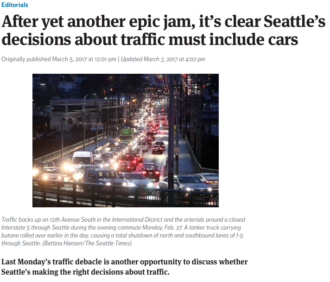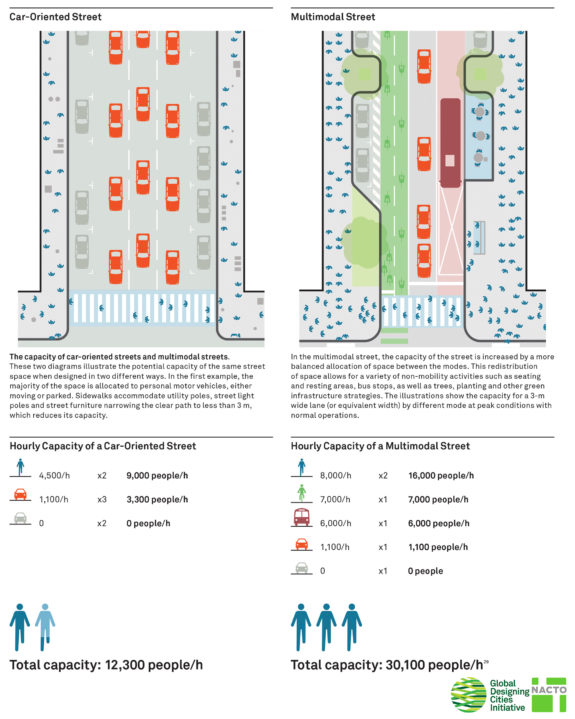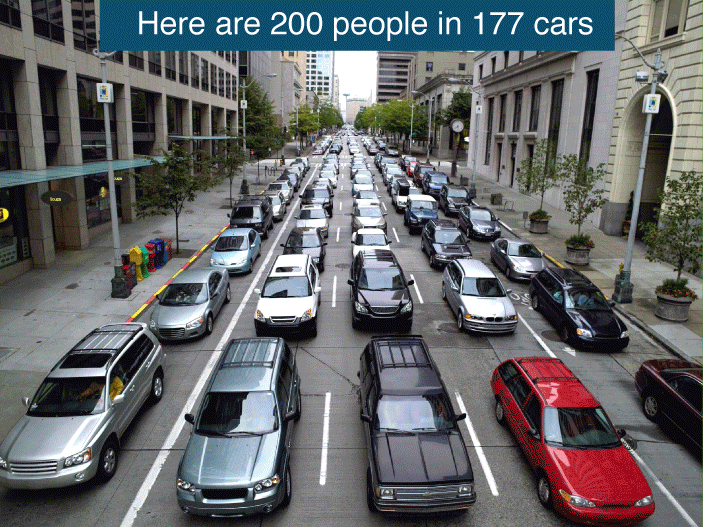After a butane truck crash on I-5 snarls traffic, the Times Ed Board blames … bike lanes?

Screenshot from the Seattle Times (click to read)
It seemed every couple minutes, someone at KUOW radio would break into the news broadcast to let people know of another major traffic problem in the Seattle area. It was February 27, and a truck carrying butane had crashed on southbound I-5 downtown.
The very hazardous payload forced brave emergency crews to close both directions of the major freeway at the interchange with I-90. During all this, snow and hail was coming down in various amounts in different parts of the region, further complicating people's routes.
Traffic got so bad, a heroic taco truck called Tacos El Tajin that was stuck on I-5 simply opened its window and started serving other stranded travelers.
As traffic backed up, people trying to drive downtown blocked intersections and bus routes. People often use the term "gridlock" hyperbolically to describe bad traffic, but this was legitimately gridlock. Buses got more and more delayed by car traffic, reducing the effectiveness of the city's most vital congestion relief valve. Link light rail saved the day for many people as one of the only services running reliably. Those who braved rare snowy streets to bike to work that day also found ways to get out of the city relatively easily by working through the snarled traffic. Most everyone else had a long journey home.
Listening to the traffic news get worse, I joked that I wondered how long it would take before someone blamed the horrendous traffic on bike lanes. One week later, the Seattle Times Editorial Board* delivered:
Major incidents will keep happening, and their effects are worsened because Seattle eliminated numerous arterial lanes in recent years. This reduced capacity hurt on Monday.
Lanes were replaced with bicycle paths. The problem isn't adding bike paths, it's that the city did so by reducing general traffic capacity. This makes the street network less resilient and capable of handling surges - and more dependent on I-5.
It's hard to know where to start in responding to an editorial like this that is so wildly out of touch with reality in so many ways. At first I laughed. I-5 was closed in the middle of a work day and through the evening commute, but bike lanes are what caused the traffic? I mean, that's legitimately funny.
But there are many people who were stuck in that traffic mess who are looking for someone to blame, and people biking are convenient scape goats. The region's largest newspaper is using this obviously-unrelated traffic mess to argue against sorely needed bike safety projects. That's less funny.
So, where to begin? First, what "bicycle paths" are they referring to? The city has built exactly one bike lane downtown in recent history that displaced a general traffic lane: 2nd Ave. That was in 2014. Seattle has lots of plans for more bike lanes, but the Times Board seems unaware that those plans have been delayed. Certainly plans for bike lanes didn't cause the traffic jam, right?
But this raises a more important point: One more lane on 2nd Ave filled with stopped or crawling cars would have done nothing at all to help alleviate a total traffic system meltdown that happened last week. If anything, it would have made it worse.
Multimodal streets have more capacity than car-dominant streets. Here's a graphic demonstrating this concept from the new Global Street Design Guide by the National Association of City Transportation Officials:
And for Seattle's 2nd Ave, we just so happen to have a GIF demonstrating the same idea:
Of course, a bike lane on a downtown street is only going to fulfill its role in moving people efficiently if it connects to neighborhoods, jobs and destinations. Right now, 2nd Ave's bike lane is alone in a sea of stressful downtown streets, which is why advocates are pushing for a Basic Bike Network downtown as part of the One Center City near-term work. 2nd Ave was billed as a pilot project, yet it is still all alone two and a half years later.
If the Times wants to be outraged about the city's lack of action to address downtown congestion, they should be pushing the city to follow-through with its delayed downtown bike network. SDOT and Mayor Ed Murray are sitting on a planned and funded option for increasing capacity on downtown streets, and we can implement it very quickly if we make it a priority. So let's do it.
The editorial also says that bike lanes make downtown streets "less resilient," which is an interesting choice of words since "resilient" is one of the major adjectives Mayor Murray's Move Seattle plan uses to support its calls for more biking, walking and transit priority:
A key to building a reliable transportation system is to build a system that is resilient - a system that has enough alternate routes and modes for people that it isn't paralyzed by a construction project, a stadium event, a crash or a bridge opening.
The Seattle Times Editorial Board opposed the levy, which voters passed in 2015 by a strong margin. The people of Seattle agree with the Move Seattle principles and are ready to invest in its solutions. They understand that more people walking, biking and taking transit are the only real-life solutions we have to the problem.
Which brings us to the editorial's most dangerous and radical point:
Because Seattle straddles state freeways at their busiest points, it should be ready to absorb the traffic when they're disrupted.
Seattle is a city. Cities are places for people. Downtown Seattle is our biggest employment and destination center. It's also a neighborhood where people live. Moving a freeway worth of cars is inherently antithetical to what makes Seattle's downtown the desirable place it is.
There is no car-centric option for moving the growing number of people and goods around Seattle, and the Ed Board is delusional at best to say so (I dusted and found Brier Dudley's fingerprints all over this one). American cities (including Seattle) have tried to follow the Ed Board's windshield dream for the better part of a century, and we've found that it is impossible to remake city streets so they can carry more cars. Everything we do to meet demand creates even more demand:
We invest heavily in efforts to move more cars > streets become more dangerous and less comfortable > biking, walking and transit become less desirable > more people choose to drive > people stuck in traffic make calls for more car capacity > repeat until downtown is destroyed or the people yell "Stop!"
Across the nation, downtowns were hollowed out, business districts declined, neighborhoods were displaced and the traffic still got worse.
In the process, an unimaginable number of people were killed. Last year alone, more than 40,000 people died in American traffic collisions. Many times more were seriously injured, leaving them with lifelong injuries. The same amount of death and injury will continue until we do something to change it. The Ed Board's take on downtown traffic is callous in ignoring the importance of protecting health and safety of our neighbors.
What's so frustrating about this latest editorial is that the Ed Board is moving backward. In 2013, a year before the 2nd Ave bike lane opened, the Board penned an editorial supporting a network of safe bike lanes and neighborhood greenways, saying "Seattle should be in the vanguard" in building "a safe, comprehensive bike network." They essentially called for the city build bike lanes like 2nd Ave. Now they are blaming the city for following through?
I get that there's been changeover on the Board since 2013, but it's pretty ridiculous to call for bike lanes, then turn around a few years later and say those same bike lanes are proof that the city is engaging in an imagined anti-car conspiracy.
Seattle must commit to its multimodal vision. I hope that by the time One Center City changes hit the ground, the Times Ed Board will have reconnected with the transportation needs of a 21st Century city.
* I want to be clear that there is a difference between the Times Editorial Board and the reporters doing very valuable and important work for the paper. I do not think frustrating editorials are a good reason to pull a subscription because we need a strong Seattle Times reporting staff. But the Ed Board ain't doing reporters any favors by publishing absurd editorials like this under the same masthead.

